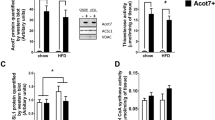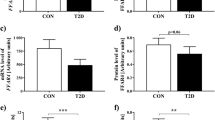Abstract
Long chain acyl-CoA synthetase (ACSL) is an enzyme that activates fatty acids before they are further metabolized. ACSL6 is the one of main ACSL isoforms exclusively expressed in skeletal muscle, but the consequences of the suppression of this gene in systemic glucose homeostasis has yet to be reported. Hence, we investigated the roles of ACSL6 gene in glucose tolerance and TAG distribution in physiological conditions. Eight-week-old male C57BL/6J mice were administered with control or Acsl6 siRNAs and then fed with either AIN-93 control diet or high fat diet. At seven days after the first siRNA injection, oral glucose tolerance tests and TAG quantification were performed. In vivo administration of Acsl6 siRNA decreased Acsl6 expression only in skeletal muscle under AIN-93 or a high fat diet. However Acsl6 siRNA injection to animals increased TAG accumulation in the liver without the change of Acsl6 expression. Atelocollagen mediated Acsl6 suppression enhanced whole-body glucose tolerance coinciding with decreased TAG accumulation in skeletal muscle of mice fed an AIN-93 diet. However, the improved glucose tolerance by Acsl6 reduction was ablated by high fat diet. Moreover reduced Acsl6 did not alter the phosphorylation of insulin signaling proteins in skeletal muscle. These results suggest that Acsl6 reduction in skeletal muscle enhances glucose homeostasis and dissociates the insulin responses from TAG accumulation in skeletal muscle.
Similar content being viewed by others
References
Fabbrini, E., F. Magkos, B. S. Mohammed, T. Pietka, N. A. Abumrad, B. W. Patterson, A. Okunade, and S. Klein (2009) Intrahepatic fat, not visceral fat, is linked with metabolic complications of obesity. Proc. Natl. Acad. Sci. US. 106: 15430–15435.
Haemmerle, G., A. Lass, R. Zimmermann, G. Gorkiewicz, C. Meyer, J. Rozman, G. Heldmaier, R. Maier, C. Theussl, S. Eder, D. Kratky, E. F. Wagner, M. Klingenspor, G. Hoefler, and R. Zechner (2006) Defective lipolysis and altered energy metabolism in mice lacking adipose triglyceride lipase. Scienc. 312: 734–737.
Pan, D. A., S. Lillioja, A. D. Kriketos, M. R. Milner, L. A. Baur, C. Bogardus, A. B. Jenkins, and L. H. Storlien, (1997) Skeletal muscle triglyceride levels are inversely related to insulin action. Diabete. 46: 983–988.
Minehira, K., S. G. Young, C. J. Villanueva, L. Yetukuri, M. Oresic, M. K. Hellerstein, R. V. Farese, J. D. Jr. Horton, F. Preitner, B. Thorens, and L. Tappy (2008) Blocking VLDL secretion causes hepatic steatosis but does not affect peripheral lipid stores or insulin sensitivity in mice. J. Lipid Res. 49: 2038–2044.
Monetti, M., M. C. Levin, M. J. Watt, M. P. Sajan, S. Marmor, B. K. Hubbard, S. D. Stevens, J. R. Bain, C. B. Newgard, R. V. Sr. Farese, A. L. Hevener, and R. V. Jr. Farese (2007) Dissociation of hepatic steatosis and insulin resistance in mice overexpressing DGAT in the liver. Cell Metab. 6: 69–78.
Levin, M. C., M. Monetti, M. J. Watt, M. P. Sajan, R. D. Stevens, J. R. Bain, C. B. Newgard, R. V. Sr. Farese, and R. V. Jr. Farese (2007) Increased lipid accumulation and insulin resistance in transgenic mice expressing DGAT2 in glycolytic (type II) muscle. Am. J Physiol Endocrinol. Meta. 293: E1772–E1781.
Galgani, J. E., C. Moro, and E. Ravussin (2008) Metabolic flexibility and insulin resistance. Am. J. Physiol. Endocrinol. Metab. 295: E1009–E1017.
Bu, S. Y., M. T. Mashek, and D. G. Mashek (2009) Suppression of long chain acyl–CoA synthetase 3 decreases hepatic de novo fatty acid synthesis through decreased transcriptional activity. J. Biol. Chem. 284: 30474–30483.
Bu, S. Y. and D. G. Mashek (2010) Hepatic long–chain acyl–CoA synthetase 5 mediates fatty acid channeling between anabolic and catabolic pathways. J. Lipid Res. 51: 3270–3280.
Li, L. O., J. M. Ellis, H. A. Paich, S. Wang, N. Gong, G. Altshuller, R. J. Thresher, T. R. Koves, S. M. Watkins, D. M. Muoio, G. W. Cline, G. I. Shulman, and R. A. Coleman (2009) Liver–specific loss of long chain acyl–CoA synthetase–1 decreases triacylglycerol synthesis and beta–oxidation and alters phospholipid fatty acid composition. J. Biol. Chem. 284: 27816–27826.
Mashek, D. G., L. O. Li, and R. A. Coleman (2007) Long–chain acyl–CoA synthetases and fatty acid channeling. Future. Lipidol. 2: 465–476.
Bowman, T. A., K. R. O’Keeffe, T. D’Aquila, Q. W. Yan, J. D. Griffin, E. A. Killion, D. M. Salter, D. G. Mashek, K. K. Buhman, and A. S. Greenberg (2016) Acyl CoA synthetase 5 (ACSL5) ablation in mice increases energy expenditure and insulin sensitivity and delays fat absorption. Mol. Metab. 5: 210–220.
Puri, V., S. Ranjit, S. Konda, S. M. Nicoloro, J. Straubhaar, A. Chawla, M. Chouinard, C. Lin, A. Burkart, S. Corvera, R. A. Perugini, and M. P. Czech (2008) Cidea is associated with lipid droplets and insulin sensitivity in humans. Proc. Natl. Acad. Sci. US. 105: 7833–7838.
Li, L. O., T. J. Grevengoed, D. S. Paul, O. Ilkayeva, T. R. Koves, F. Pascual, C. B. Newgard, D. M. Muoio, and R. A. Coleman (2015) Compartmentalized acyl–CoA metabolism in skeletal muscle regulates systemic glucose homeostasis. Diabete. 64: 23–35.
Mashek, D. G., L. O. Li, and R. A. Coleman (2006) Rat longchain acyl–CoA synthetase mRNA, protein, and activity vary in tissue distribution and in response to diet. J. Lipid Res. 47: 2004–2010.
Marszalek, J. R., C. Kitidis, A. Dararutana, and H. F. Lodish (2004) Acyl–CoA synthetase 2 overexpression enhances fatty acid internalization and neurite outgrowth. J. Biol. Chem. 279: 23882–23891.
Marszalek, J. R., C. Kitidis, C. C. Dirusso, and H. F. Lodish (2005) Long–chain acyl–CoA synthetase 6 preferentially promotes DHA metabolism. J. Biol. Chem. 280: 10817–10826.
Yuan, Y., N. Makita, D. Cao, K. Mihara, K. Kadomatsu, and Y. Takei (2015) Atelocollagen–mediated intravenous siRNA delivery specific to tumor tissues orthotopically xenografted in prostates of nude mice and its anticancer effects. Nucleic Acid Ther. 25: 85–94.
Forootan, S. S., Z. Z. Bao, F. S. Forootan, L. Kamalian, Y. Zhang, A. Bee, C. S. Foster, and Y. Ke (2010) Atelocollagen–delivered siRNA targeting the FABP5 gene as an experimental therapy for prostate cancer in mouse xenografts. Int. J. Oncol. 36: 69–76.
Toyooka, T., H. Nawashiro, N. Shinomiya, and K. Shima (2011) Down–regulation of glial fibrillary acidic protein and vimentin by RNA interference improves acute urinary dysfunction associated with spinal cord injury in rats. J. Neurotrauma 28: 607–618.
BLIGH, E. G., and W. J. DYER (1959) A rapid method of total lipid extraction and purification. Can. J. Biochem. Physiol. 37: 911–917.
Ong, K. T., M. T. Mashek, S. Y. Bu, A. S. Greenberg, and D. G. Mashek (2011) Adipose triglyceride lipase is a major hepatic lipase that regulates triacylglycerol turnover and fatty acid signaling and partitioning. Hepatolog. 53: 116–126.
Gancheva S., T. Jelenik, E. Alvarez–Hernandez, and M. Roden (2018) Interorgan metabolic crosstalk in human insulin resistance. Physiol. Rev. 98: 1371–1415.
Choi, J. W. and J. W. Yun (2016) Prohibitin seficiency causes opposing lipid metabolism between 3T3–L1 adipocytes and Clone 9 hepatocytes. Biotechnol. Bioproc. Eng. 21: 294–298.
Sitnick, M. T., M. K. Basantani, L. Cai, G. Schoiswohl, C. F. Yazbeck, G. Distefano, V. Ritov, J. P. DeLany, R. Schreiber, D. B. Stolz, N. P. Gardner, P. C. Kienesberger, T. Pulinilkunnil, R. Zechner, B. H. Goodpaster, P. Coen, and E. E. Kershaw (2013) Skeletal muscle triacylglycerol hydrolysis does not influence metabolic complications of obesity. Diabete. 62: 3350–3361.
Ong, K. T., M. T. Mashek, S. Y. Bu, and D. G. Mashek (2013) Hepatic ATGL knockdown uncouples glucose intolerance from liver TAG accumulation. FASEB J. 27: 313–321.
Bosma, M., M. K. Hesselink, L. M. Sparks, S. Timmers, M. J. Ferraz, F. Mattijssen, D. van Beurden, G Schaart, M. H. de Baets, F. K. Verheyen, S. Kersten, and P. Schrauwen (2012) Perilipin 2 improves insulin sensitivity in skeletal muscle despite elevated intramuscular lipid levels. Diabete. 61: 2679–2690.
Lass, A., R. Zimmermann, G. Haemmerle, M. Riederer, G. Schoiswohl, M. Schweiger, P. Kienesberger, J. G. Strauss, G. Gorkiewicz, and R. Zechner. (2006) Adipose triglyceride lipase–mediated lipolysis of cellular fat stores is activated by CGI–58 and defective in Chanarin–Dorfman Syndrome. Cell Metab. 3: 309–319.
Zhang, W., S. Y. Bu, M. T. Mashek, I. Sullivan, Z. Sibai, S. A. Khan, O. Ilkayeva, C. B. Newgard, D. G. Mashek, and T. G. Unterman (2016) Integrated regulation of hepatic lipid and glucose metabolism by adipose triacylglycerol lipase and FoxO proteins. Cell Rep. 15: 349–359.
Seldin, M. M., X. Lei, S. Y. Tan, K. P. Stanson, Z. Wei, and G. W. Wong (2013) Skeletal muscle–derived myonectin activates the mammalian target of rapamycin (mTOR) pathway to suppress autophagy in liver. J. Biol. Chem. 288: 36073–36082.
Acknowledgement
This research was supported by a Basic Science Research Program through the National Research Foundation of Korea (NRF) funded by the Ministry of Education, Science and Technology (MEST)(2012R1A1A1019253).
Author information
Authors and Affiliations
Corresponding author
Rights and permissions
About this article
Cite this article
Lee, J.Y., Kim, AR., Jung, YH. et al. Dissociation of Systemic Glucose Homeostasis from Triacylglyceride Accumulation by Reduced Acsl6 Expression in Skeletal Muscle. Biotechnol Bioproc E 23, 465–472 (2018). https://doi.org/10.1007/s12257-018-0261-1
Received:
Revised:
Accepted:
Published:
Issue Date:
DOI: https://doi.org/10.1007/s12257-018-0261-1




